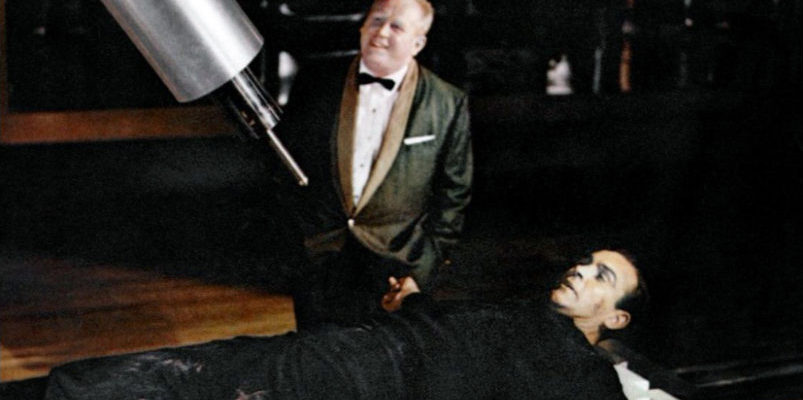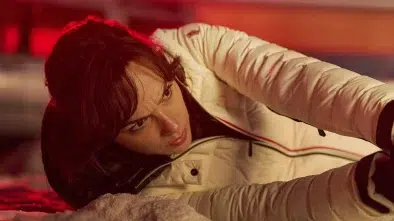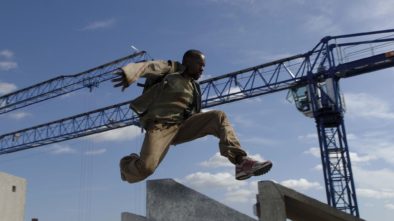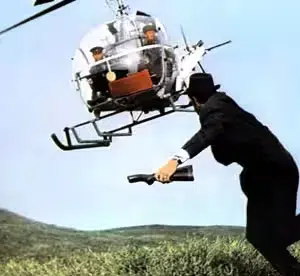Goldfinger’s Laser: How Movie Serials Influenced Bond’s Near Castration–And Why It Replaced Dissection By Buzzsaw in Ian Fleming’s Novel
The third James Bond film, Goldfinger, turned agent 007 into a global phenomenon. His popularity had built over the two previous films but it had been difficult to crack the US market. That all changed with Goldfinger, and globally, audiences resonated with the film’s perfect blend of suspense and humor, and realism and fantasy. The scene that captures this perfect mix the most is the one that features an industrial laser versus Bond’s gonads, otherwise known as the most famous near castration in cinema history.
The industrial laser inching ever closer to Bond’s nether regions is an update of the buzzsaw in Ian Fleming’s novel of the same name. But a buzzsaw just wasn’t cool enough or original enough for James Bond in the film adaptation. Using a buzzsaw to dissect the hero had been done to death in many movie serials like Spy Smasher, that famous serial that had a well-known influence on Raiders of the Lost Ark and a lesser-known influence on the James Bond film series.
Goldfinger’s screenwriter Richard Maibaum and director Guy Hamilton replaced the buzzsaw with an industrial laser to produce one of the most iconic scenes in the Bond series. What is remarkable is the laser itself. It was a concept that was rarely seen on film by 1964, and it remains one of the most realistic laser scenes today.
Finding the Perfect Effect
Sean Connery was strapped to the table for three days in March 1964. He was not only uncomfortable, but he was also in real danger. Originally the production tried a real laser which produced a very thin line. It looked great in the dark but vanished under the studio lights. Special Effects technician John Stears decided to paint in the laser optically in post-production.
But they had to create the effect of the laser melting the table as it inches closer and closer to Bond’s groin. That was a very real effect created by a welding torch. To make matters more dangerous, the operator was under the table and out of sight. He couldn’t see Connery, but he nonetheless had to work his way up with the torch and cut very close to the Scottish actor without accidentally burning him.
“We had to pre-cut the area which is going to melt,” said Optical Effects Designer Cliff Culley in the documentary Inside Goldfinger. “Then, very carefully, fill the whole lot in with solder. And then make the top finish again look like gold. I was underneath that thing. That table. The gun was acetylene that was cutting the channel. Somebody had to go under there, of course, in case something went wrong at the last minute, and it didn’t stop when it should. It came awful close.”
The great image of an industrial laser cutting through a solid gold table was aided by the incredible set built by production designer Ken Adam on Pinewood Studio’s E Stage, and also the terrific tense edge-of-your-seat pacing created by a combination of John Barry’s musical talents and Peter Hunt’s expert editing.
The Perfect Blend of Sound and Editing Increase Tension
Barry’s soundtrack–named “The Laser Beam” on the British LP–rises and falls to follow the incredible way Hunt oscillates between fast and slow edits to wind up the tension in the viewer, which will be explained in depth shortly.
Barry’s choice of music is a repeated figure of violin strings and a slow build of a bass underneath. The use of violin strings, in particular, is excruciating. Barry gives them a pleading sound to mimic the desperation on Bond’s face and in his voice as he searches for the right statement that will convince Goldfinger to turn the laser off.
Hunt builds the tension agonizingly throughout the scene. As the laser inches ever closer, the strings of the violins sound ever more pleading, accompanying close-ups of Bond’s face. It’s one of those rare times we see James Bond sweat. It’s the most tense-filled scene in the film; the tensest scene in any of Connery’s Bond films. Hunt edits together a succession of shots that take us back and forth from the tense look on Bond’s face, to the laser melting the table, and then to Goldfinger’s nonchalant and often amused expression. Hunt slows the pacing down when Bond and Goldfinger are talking but speeds it up when they’re not. This establishes a rhythm of Bond’s panic and his panic becomes the audience’s panic.
The tension is made even more memorable by the director’s decision to have Goldfinger walk closer and closer to the exit, after he rebuffs each of Bond’s attempts to get him to turn the laser off. Bond’s attempts to find a suitable comment to convince Goldfinger to turn off the laser only halt Goldfinger’s movement toward the door momentarily. After each rebuff, Hunt speeds the pacing up again. The laser is inching closer and closer to Bond’s groin, and Goldfinger is getting closer and closer to that exit. Bond tries something else, only for Goldfinger to knock Bond back again. The pacing increases again. Bond is desperate. We’re desperate. We’re on the edge of our seats. How is Bond going to get out of this?
This is the critical question the audience asks themselves and it is a question audiences would ask themselves more and more while watching future Bond films. While that tension and feeling of no way out for Bond originate in Goldfinger, the concept comes from cliffhangers in movie serials. Every episode of a movie serial ended in a dire situation that seemed inescapable for the hero. The audience would have to return to the cinemas the following week to see how he or she escaped.
While the basic idea is lifted from cliffhangers, it is improved significantly in this scene. The overreliance on long shots in movie serials is replaced by Goldfinger’s more sophisticated use of shots that get continually closer to Bond’s face as the scene progresses. Guy Hamilton’s smart direction, the back and forth between Bond and Goldfinger, and the tense use of sound and edits were modern and sophisticated for the time and contribute to how suspense and action are shot today.
A Detailed Look At The Pacing
Let’s break it down further to show just how deliberately paced this scene is.
The scene begins with no music, just the sounds of whirring electronics and the subtle sound of a ticking clock, which is associated in the viewer’s mind with a countdown to disaster or running out of time. Goldfinger gives a rundown of the intensity of the laser beam and how it can cut through solid metal. “Here, I will show you,” he says. And the music begins as soon as he snaps his fingers to signal a technician to switch the laser on.
This is the first time we’ve seen Bond so helpless, so vulnerable. There are no gadgets to get him out of this situation. Goldfinger has the gadget and the upper hand. All Bond has is a small window of time to trick Goldfinger into believing he is more valuable alive.
The conversation doesn’t begin well. Bond is cocky. Goldfinger tells him “Choose your next witticism carefully Mister Bond, it may be your last.”
Bond’s confidence and cockiness soon fade when he realizes Goldfinger is not bluffing after the immortal exchange:
BOND: “Do you expect me to talk?”
GOLDFINGER: “No Mister Bond. I expect you to die.”
The dialogue is fantastic. We have that perfect blend of humor and seriousness. As the scene progresses, Bond’s dialogue turns more and more desperate, and Goldfinger becomes more defiant. After Goldfinger delivers his famous retort, he dismisses Bond and walks towards the exit. This isn’t a game. Bond better think quickly.
The first violin string quivers as Bond sees Goldfinger talking to Mr. Ling, an expert in nuclear fission. Goldfinger is a meter from the exit. You can see the desperation on Bond’s face as he looks at Goldfinger, then back at the laser. We see the laser is between Bond’s ankles now. Bond offers a rather weak bluff. “If I fail to report, 008 will replace me”. Goldfinger smugly retorts, “I trust he will be more successful.” Goldfinger turns to leave.
The first desperate, pleading sound of the violin begins. The camera has closed in on Bond’s face. Then back to the laser, which is now between his knees.
Bond thinks he has the answer when he mentions that 008, like him, knows about “Operation Grandslam”, the name of Goldfinger’s plan. This comment stops Goldfinger dead in his tracks just as he is walking through the exit. He turns. There is an excruciating delay (almost twenty seconds) before Goldfinger answers. During that time, there is a succession of tense cuts from Hunt. A couple of extreme close-ups of Bond turning his head from the laser to Goldfinger and back to the laser again. We see the laser is inches from his groin now. All the while, Goldfinger is in discussion with Mr. Ling. Goldfinger still looks relaxed; Ling doesn’t. Finally, Goldfinger responds: “Two words you overheard that could not possibly have any meaning to you or your organization.”
The pleading sound of the violins is at its zenith. The excruciating sound makes the viewer want to be put out of their misery too.
But Bond has him now. He says, “Can you afford to take that chance?” There are still another ten or so seconds before the laser is switched off. And the music begins to fade. Goldfinger responds: “You’re quite right, Mr. Bond. You’re worth more to me alive.”
Bond is relieved and so is the audience. But the scene has one more trick up its sleeve. Immediately following this relief, the audience–and Bond– experience a bit of cognitive dissonance. As Goldfinger says Bond is worth more to him alive, his assistant Kisch fires a gun into Bond’s side. Bond loses consciousness. And the scene fades to black. It’s only in the next scene that the audience discovers Bond was shot with a tranquilizer gun. The “knock-out shot” is quite a familiar trope today, but not in 1964 when Goldfinger hit theaters. Goldfinger was the first film to introduce the idea to moviegoers.
This scene–and its continual mind games–is what edge-of-the-seat means: the ability to place the audience in the shoes and the psychology of the hero and keep them guessing. Pacing is exacting, a science. All the elements had to come together perfectly in order to pull this scene off. Along with the combination of sound, music, editing, and special effects, this tense 2 minutes and 40 seconds of screen time is a superbly acted, written, and directed scene representing the high point in James Bond that has been rarely reached and never surpassed.




